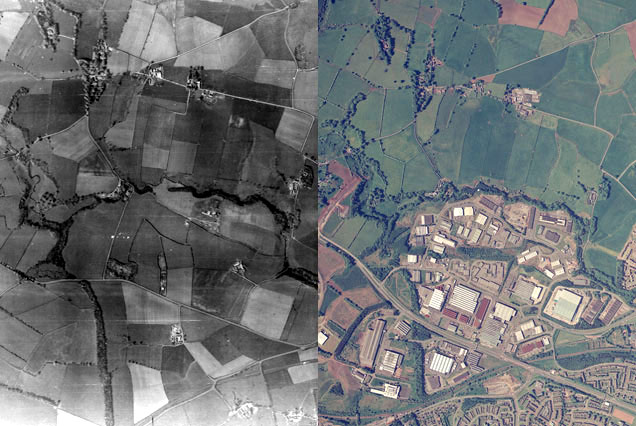Topic 12 Trees (Part 2)
Exercises
You can download a template RMarkdown file to start from here.
Context
Our goal will be to classify types of urban land cover in small subregions within a high resolution aerial image of a land region. Data from the UCI Machine Learning Repository include the observed type of land cover (determined by human eye) and “spectral, size, shape, and texture information” computed from the image. See this page for the data codebook.

Source: https://ncap.org.uk/sites/default/files/EK_land_use_0.jpg
library(readr)
library(ggplot2)
library(dplyr)
library(caret)
library(rpart.plot)
# Read in the data
land <- read_csv("https://www.macalester.edu/~ajohns24/data/land_cover.csv")
# There are 9 land types, but we'll focus on 3 of them
land <- land %>%
filter(class %in% c("asphalt", "grass", "tree"))Exercise 1: Predictions from trees
Last time, we built a classification tree to predict land type of an image patch (class) from the spectral, size, shape, and texture predictors in the dataset.
Looking at the plot of the fitted tree, manually make a soft (probability) and hard (class) prediction for the case shown below. (See page 3 of the
rpart.plotpackage vignette for a refresher on what the plot shows.)set.seed(186) tree_mod <- train( class ~ ., data = land, method = "rpart", tuneGrid = data.frame(cp = seq(0, 0.5, length.out = 50)), trControl = trainControl(method = "cv", number = 10, selectionFunction = "oneSE"), metric = "Accuracy", na.action = na.omit ) rpart.plot(tree_mod$finalModel) # Pick out training case 2 to make a prediction test_case <- land[2,] # Show only the needed predictors test_case %>% select(NDVI, Bright_100, SD_NIR)Verify your predictions with the
predict()function. (Note: we introduced this code in Logistic Regression, but this type of code applies to any classification model fit incaret).# Soft (probability) prediction predict(tree_mod, newdata = test_case, type = "prob") # Hard (class) prediction predict(tree_mod, newdata = test_case, type = "raw")
Exercise 2: Reinforcing the BVT
Last time, we looked at a number of different tuning parameters that impact the number of splits in a tree. Let’s focus on minbucket described below.
minbucket: the minimum number of observations in any leaf node.
How would you expect a plot of test accuracy (how is test accuracy estimated again?) vs.
minbucketto look, and why? (Draw it!) What part of the plot corresponds to overfitting? To underfitting?How would you expect a plot of training accuracy vs.
minbucketto look, and why? (Draw it!) What part of the plot corresponds to overfitting? To underfitting?
Exercise 3: Variable importance in trees
We can obtain numerical variable importance measures from trees. These measure, roughly, “the total decrease in node impurities from splitting on the variable” (even if the variable isn’t ultimately used in the split).
What are the 3 most important predictors by this measure? Does this agree with you might have expected based on the plot of the fitted tree in Exercise 1? What might greedy behavior have to do with this?
tree_mod$finalModel$variable.importanceExercise 4: Regression trees
As discussed in the video, trees can also be used for regression! Let’s work through a step of building a regression tree by hand.
For the two possible splits below, determine the better split for the tree by computing the sum of squared residuals as the measure of node impurity. (The numbers following Yes: and No: indicate the outcome value of the cases in the left (Yes) and right (No) regions.)
Split 1: x1 < 3
- Yes: 1, 1, 2, 4
- No: 2, 2, 4, 4
Split 2: x1 < 4
- Yes: 1, 1, 2
- No: 2, 2, 4, 4, 4Extra!
In case you want to explore building regression trees in R, try out the following exercises using the College data from the ISLR package. Our goal was to predict graduation rate (Grad.Rate) as a function of other predictors. You can look at the data codebook with ?College in the Console.
library(ISLR)
data(College)
# A little data cleaning
college_clean <- College %>%
mutate(school = rownames(College)) %>%
filter(Grad.Rate <= 100) # Remove one school with grad rate of 118%
rownames(college_clean) <- NULL # Remove school names as row namesAdapt our general decision tree code for the regression setting by adapting the
metricused to pick the final model. (Note how other parts stay the same!)- Note about tuning the
cpparameter:rpartuses the R-squared metric to prune branches. (The R-squared metric must increase bycpat each step for a split to be considered.)
set.seed(132) tree_mod_college <- train( Grad.Rate ~ ., data = college_clean, method = "rpart", tuneGrid = data.frame(cp = seq(0, 0.2, length = 50)), trControl = trainControl(method = "cv", number = 10, selectionFunction = "oneSE"), metric = ___, na.action = na.omit )- Note about tuning the
Plot test performance as a function of
cp, and comment on the shape of the plot.Plot the “best” tree. (See page 3 of the
rpart.plotpackage vignette for a refresher on what the plot shows.) Do the sequence of splits and outcomes in the leaf nodes make sense?Look at the variable importance metrics from the best tree. Do the most important variables align with your intuition?